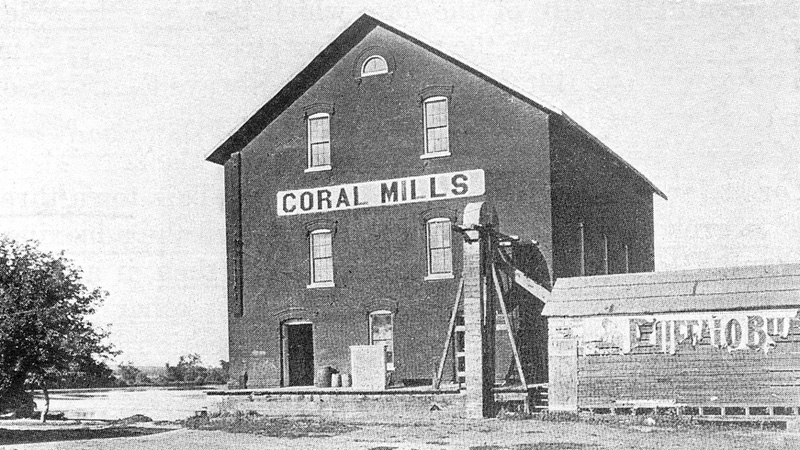
As
site of the first operating mill site on the Iowa River, Coralville offered
area pioneers the best location in Johnson County
The original flour mill at the Coralville dam site shows here rebuilt in brick after a fire in 1873.
By
Bob Hibbs
If
Coralville causes Iowa City people confusion today over shopping, taxing and
civic issues, it has been confusing local historians for at least 150 years.
It occasionally even confuses itself.
Pioneers
determined that Coralville offered the best water power site along the Iowa
River in Johnson County. A long flat stretch of river would create good
pressure on flows at a mill on a spot where the Coralville member of the Cedar
Valley limestone formation was nearly exposed, creating firm foundation.
The
potential proved irresistible to Iowa City investors – who promptly went
broke. None-the-less, it would prove highly profitable to later owners Ezekiel
Clark for whom Clarksville was named and his brother-in-law, Samuel Kirkwood,
who became Iowa’s beloved Civil War governor.
It
also became site of one of the worst industrial accidents in county history,
killing six men in an explosion July 23, 1875, at the Close paper mill, which
was rebuilt.
The
first mill at Coralville was opened Jan. 1, 1844, grinding grain into meal or
flour. The dam was 10 feet high, and a half-dozen other mills sprang up there
through the years.
The
following spring Walter Terrell opened his directly-competing grist mill at an
Iowa City site along present-day North Dubuque Street near Mayflower Residence
Hall. He had built his five-foot-high dam the previous summer, prompting some
historians to tag Terrell the first mill.
Confusion
also arises from licensing dates; and, distinctions between Coralville and
Iowa City. Terrell got the
earliest permit for a dam on the Iowa River, but did not build it until nearly
three years later when it was about to expire. The Dec. 15, 1840, license date
is sometimes cited as opening of the Terrell mill. Terrell was first at Iowa
City.
However,
neither Coralville nor Iowa City saw the first water-powered mill in Johnson
County. That distinction goes to
the flour mill erected by David and Joshua Switzer on Clear Creek in 1839.
Several rural saw and woolen mills followed, and hydroelectric power
generation came later. Terrell’s mill was an immediate success, which continued during 23 years of Terrell ownership. Despite an initial flourish, the Coralville mill floundered and was closed. In 1848 it was purchased by Iowa City banker Clark, who induced his lawyer brother-in-law in Illinois to come operate the mill. Kirkwood’s wife, Jane, was Clark’s much younger sister. Once here, Kirkwood not only successfully ran the mill, but soon entered a long political career which extended not only to the Iowa governor’s office, but also to the U.S. Senate and into cabinets serving two presidents. When it comes to confusing itself, though, Coralville begins with its own name. The usual yarn is that it originally was called Clarksville, but couldn’t get a post office, so was forced to use Coralville to satisfy the feds. That tale is a string of half-truths, misinterpretations and balderdash. The two existed simultaneously, essentially competitors. Any property abstract north of the current Fifth Street Place (about 300 feet north of Fifth Street) will show it originally was in Clarksville. An abstract for an area south of that line will show being in Coralville. Coralville got a post office which originally sat in what now is First Avenue just north of Fifth Street near the Iowa River Power restaurant. It prospered while Clarksville died. Coralville got the post office plum, so the fact of another town with the Clarksville name existing in Iowa may not have mattered at all. An easy source of the dueling towns is the 1900 Atlas of Johnson County, which labels what is now called First Avenue as Rogers Street in Coralville, and Water Street to the north in Clarksville. Coralville now features numbered streets running east-west, with numbered avenues running north-south, the probable source of most confusion in Coralville today. Or, do avenues run east-west? Next Saturday: Iowa City’s first bell, a real clunker! Bob Hibbs collects local postcards and researches history related to them.
|
